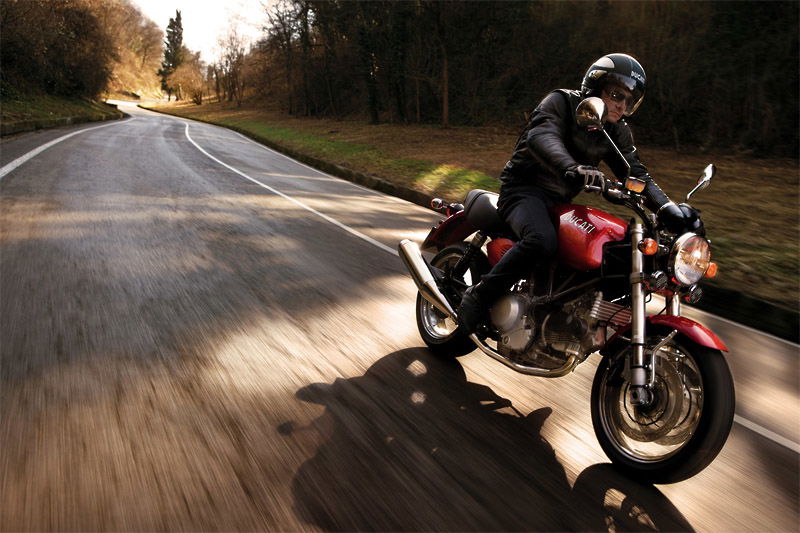Advanced Motorcycle Riding Course: Relax
Visordown’s tame riding guru Andy Morrison starts with the very fundamentals of brilliant riding: the need to be relaxed

���
�
Watch any really good rider, whether they’re riding trials, speedway, motocross, road racing or on the road, and they all share a common attribute; they look relaxed on the bike. There is, needless to say, a very good reason for this – motorbikes work more efficiently with a relaxed rider onboard. This is particularly so when cornering. Ask any rider what they most enjoy about motorcycling and they’ll probably tell you it’s taking the bike through a succession of sweeping corners. For this reason any technique aimed at trying to improve cornering will naturally enhance the enjoyment factor.
A tense rider will not allow the steering and suspension to operate efficiently, and will consequently take a wider arc through any given corner at a given speed and lean angle than the relaxed rider. Particularly when the road surface is less than billiard-table smooth. Staying loose and relaxed will allow the bars to oscillate a little, something they need to do as the bike passes over surface imperfections bumps and cambers if it is to remain on the chosen line. If you need proof of this look no further than onboard camera footage from the Isle of Man TT. If the rider tried to physically control these oscillations his bike would become uncontrollable.
Achieving a relaxed state while riding can be more difficult than you imagine. There are myriad factors conspiring to add tension; extremes of weather, other road users and poor road surfaces to name but three. We can’t control these but we do have the ability to control some personal factor and stresses such as clothing fit and suitability, realistic travel distances and timing, regular breaks and remaining calm in the face of others’ stupidity. One of the main areas we can focus on is adjusting our riding style to factor in a relaxed, loose style.
From an instructor’s point of view the tense rider is easy to spot; little movement in the upper body, shocks from the front forks transmitting through the arms to the body, a machine that doesn’t appear to be handling that well. Ask these riders if they feel any aches and pains after a ride and invariably they’ll tell you their shoulders ache and that they sometimes suffer pins and needle in the hands. Learning to relax will improve your machine control and ultimately make you a become smoother, faster rider as a result. It’s absolutely key to everything that follows.
Body Language
�
Lightness of touch
You get more information about what the bike’s doing through the bars than any other source. Yes information flows from through your backside and feet, but the hands are the most sensitive to subtle feedback. To ensure you feel this feedback, the hands need to be as relaxed and loose on the bars as possible. Your throttle hand for instance needs only to grip just enough to prevent it slipping on the twistgrip. The left hand’s grip can be even lighter. In describing this grip I often use the analogy of holding a small bird (feathered, naturally) trying to prevent its escape but avoiding any level of grip that might injure it.
Elbows bent and loose
As an experiment, next time you sit on the bike grip the bars firmly and notice how rigid and inflexible your elbows become even if there is a bend in them. When you ride the bike, bring this grip level right back to the minimum and notice how relaxed your lower and upper arms become. This naturally reduces the amount of tension and therefore the potential for aches across the shoulders. More importantly it also allows the bars to oscillate which in turn, helps the bike turn and corner more efficiently – all of a sudden the bike seems to handle better.
So a good bend in the arm is essential but it needs to be free of tension if it is to serve any useful purpose. Keeping them relaxed and bent allows them to act like personal shock absorbers, preventing jolts and shocks from the bars being transmitted through the arms to the body.
Many riders, particularly those with sportsbikes tend to lean on the bars, supporting their upper body through their arms and hands. As you ride through a series of corners next, take note of what you’re doing with your upper body weight; is it being supported by your arms and hands? If so, experiment by sitting on the bike stationary, using a paddock or centrestand or, if necessary, someone to hold it upright. Lean forward to your usual riding position, keeping a good bend at the arms of course. Now stay in that position and take your hands off the bars, holding them about an inch or so above them. Now feel the muscle groups you are using to maintain that position – you’ll find it’s mostly the stomach, thigh and back muscles. While cornering and negotiating bumpy sections, use these muscle groups to help avoid pressing down on the bars. It might feel a little strange at first but these are big muscles and will soon get used to it. You can rest them in any case by taking some of the load through the arms again when not cornering or dawdling through a lower speed limit on a smooth road.

